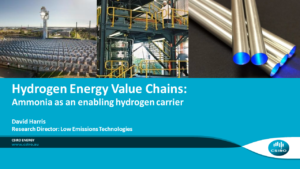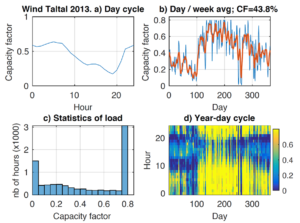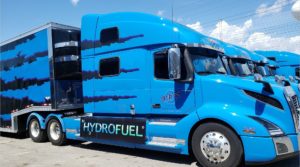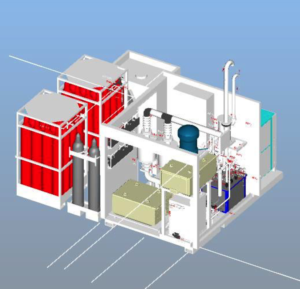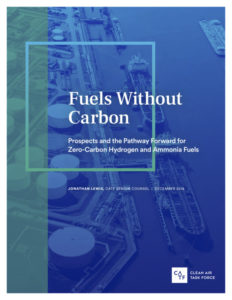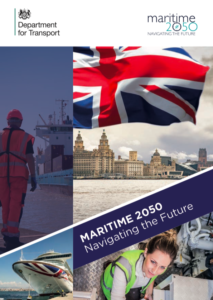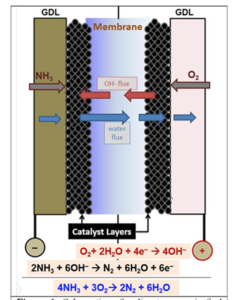The Center for Catalytic Science and Technology (CCST) at the University of Delaware has made new strides in the development of a direct ammonia fuel cell (DAFC) suitable for use in transportation applications. The progress is reported in “An Efficient Direct Ammonia Fuel Cell for Affordable Carbon-Neutral Transportation,” a paper published last month by Yun Zhao and six coauthors in the journal Joule. The paper gives an impressive account of CCST’s technical advances; and it makes a distinctly compelling case for the relevance of CCST’s work on DAFCs. In the latter regard, the authors find that ammonia has the “lowest source-to-tank energy cost by a significant margin” relative to other fuels that can be derived from renewably generated electricity. It is in society’s interest, they strongly imply, to give DAFC technology a chance to compete with hydrogen-based fuel cells in automotive applications.
Transportation Fuel
Fuel Economy Standards, and the Roles of Ammonia
In the news this week, California and four automakers (BMW, Ford, Honda and VW) signed an agreement on fuel economy standards, rising 3.7% per year to about 50 MPG in 2026. This agreement, as well as previous California and Federal standards, give automakers flexibility to meet the standards with incentives and credits for new technology such as electric, hybrid, and alternative fuel vehicles.
University of Minnesota demonstrates efficient ammonia dual-fuel engine system
This month, researchers at the University of Minnesota began successful field tests of their new ammonia engine, operating a heavy-duty tractor across farmland near Morris, MN, on a dual-fuel blend of 70% diesel and 30% ammonia.
Heavy-duty diesel trucks to be converted to use ammonia fuel in Canada
This week, Hydrofuel Inc announced a commercial demonstration project to convert diesel gensets and transport trucks to run on ammonia fuel, with the conversion work and dual-fuel operations scheduled for a three year period. The CAD $2 million (USD $1.5 million) project will take place at TFX International, in Toronto, and involves the conversion of four existing diesel-fueled assets: two stationary power generators and two transport trucks. These will be converted using Hydrofuel's "aftermarket multi-fuels engine retrofit systems," and they will thereafter be able to operate on a dual fuel basis.
AFC Energy Completes Ammonia-to-Power Trials
AFC Energy PLC, the British fuel cell company, announced on May 20 the successful conclusion of “ammonia to power (‘A2P’) fuel cell generator trials.” The result is “proof of concept” for a system consisting of an "off the shelf" ammonia cracker and a proprietary alkaline fuel cell that can readily utilize hydrogen with residual quantities of uncracked ammonia. The achievement positions AFC “to conclude work on the business case and engineering of an integrated, scalable ammonia fuelled clean power generator.”
SMARTCATS Workshop: Ammonia for Fueling Future Energy
ANNOUNCEMENT: SMARTCATS, an Action within Europe’s “intergovernmental framework” for Cooperation in Science and Technology (COST), has this week published the list of keynote speakers for its Ammonia for Fueling Future Energy Workshop, which will be held on April 13 and 14 in Lisbon, Portugal. Speakers will include John Bøgild Hansen, Senior Scientist at Haldor Topsoe and member of the Ammonia Energy Association (AEA) Board of Directors; Bill David, University of Oxford Professor and member of the AEA Advisory Board; and myself in my role as AEA President.
Fuels Without Carbon: Prospects and the Pathway Forward for Zero-Carbon Hydrogen and Ammonia Fuels
A new report from CATF, Fuels Without Carbon: Prospects and the Pathway Forward for Zero-Carbon Hydrogen and Ammonia Fuels, explores how a massive scale-up in the production and use of zero-carbon hydrogen and ammonia might help decarbonize segments of the power sector, the industrial sector, and the transportation sector (both marine and ground). Fuels Without Carbon looks at how the availability of zero-carbon hydrogen and ammonia fuels could help address several vexing climate-energy challenges, and it examines the steps that need to be taken to fully understand and address the safety and environmental risks associated with the two chemicals. Fuels Without Carbon also identifies several public and private sectors initiatives — including a few being pursued by CATF — for analyzing the opportunities and challenges associated with hydrogen and ammonia fuel, educating stakeholders about the potential benefits and risks, designing and advocating for appropriately supportive policies, and engaging with key power and mobility companies.
UK Department of Transport recommends launch of ammonia / hydrogen powered vessels within 5-15 years
In January 2019, the UK Department for Transport published a policy paper outlining its vision for the maritime sector over the coming decades. Among the many recommendations contained in Maritime 2050: navigating the future, is a medium-term objective to place "a group of hydrogen or ammonia powered domestic vessels in operation." The "strategic ambition" driving this recommendation is the expectation that "the UK will ... lead the way in taking action on clean maritime growth enjoying economic benefits from being an early adopter or fast mover." Moving forward, these recommendations will be developed into policy in the government's forthcoming Clean Maritime Plan, scheduled to be published in Spring 2019.
More Progress for Automotive-Oriented Direct Ammonia Fuel Cells
Shimshon Gottesfeld’s paper The Direct Ammonia Fuel Cell and a Common Pattern of Electrocatalytic Processes leads with a big number: “A record power density of 450 mW/cm2 has been demonstrated for a direct ammonia fuel cell [DAFC] using an alkaline membrane electrolyte.” We know it’s big because it’s 80% higher than the 250 mW/cm2 that Gottesfeld’s team had achieved in the fall of 2017 and that Gottesfeld, Adjunct Professor of Chemical Engineering at the University of Delaware, reported at the November 2017 NH3 Energy+ Topical Conference.
